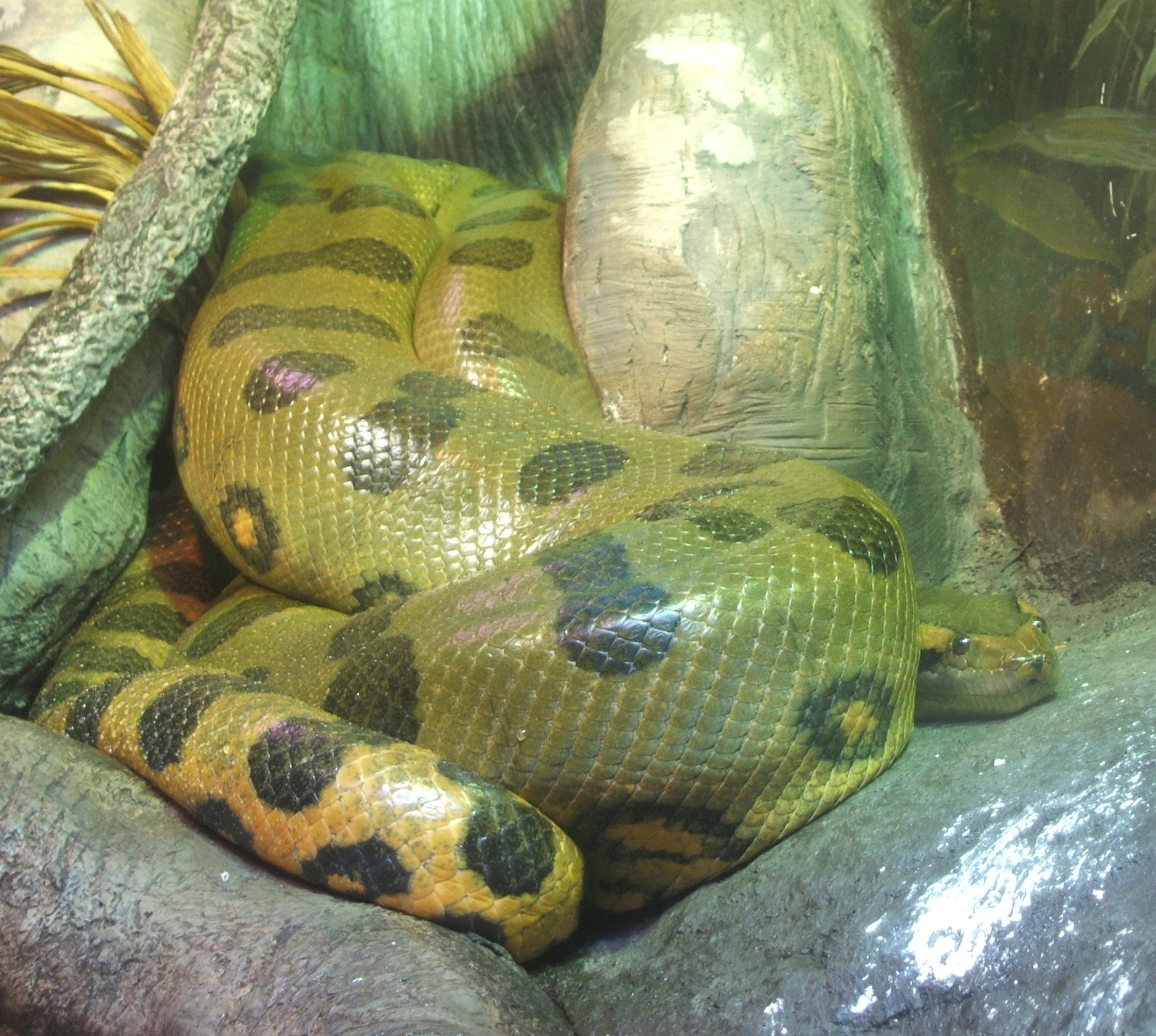|
Eunectes Murinus
The green anaconda (''Eunectes murinus''), also known as the giant Emerald anaconda, common anaconda, common water boa or sucuri, is a boa species found in South America. It is the heaviest and one of the longest known extant snake species. Like all boas, it is a non-venomous constrictor. The term " anaconda" often refers to this species, though the term could also apply to other members of the genus '' Eunectes''. Fossils of the snake date back to the Late Pleistocene in the Gruta do Urso locality. Etymology The green anaconda's specific name is derived from the Latin ', meaning 'of mice', for being thought to prey on mice. Description The green anaconda is the world's heaviest and one of the world's longest snakes, reaching a length of up to long. More typical mature specimens reportedly can range up to , with adult females, with a mean length of about , being generally much larger than the males, which average around . Weights are less well studied, though reportedly ... [...More Info...] [...Related Items...] OR: [Wikipedia] [Google] [Baidu] |
List Of Largest Snakes
The largest living snakes in the world, measured either by length or by weight, are various members of the Boidae and Pythonidae families. They include anacondas, pythons and boa constrictors, which are all non-venomous constrictors. The longest ''venomous'' snake, with a length up to , is the king cobra, and the heaviest venomous snake is likely to be the Gaboon viper (which also has the longest fangs and delivers the largest amount of venom) or possibly the Eastern diamondback rattlesnake – all three of these reach maximum weights in the range of . There are fourteen living snake species with a maximum mass of at least , as shown in the table below. This includes all species that reach a length of at least . There are two other species that reach nearly this length the Oenpelli python (binomial name ''Nyctophilopython oenpelliensis'', ''Simalia oenpelliensis'' or ''Morelia oenpelliensis''), and the olive python (''Liasis olivaceus''). The information available about th ... [...More Info...] [...Related Items...] OR: [Wikipedia] [Google] [Baidu] |
Late Pleistocene
The Late Pleistocene is an unofficial age in the international geologic timescale in chronostratigraphy, also known as Upper Pleistocene from a stratigraphic perspective. It is intended to be the fourth division of the Pleistocene Epoch within the ongoing Quaternary Period. It is currently defined as the time between c. 129,000 and c. 11,700 years ago. The Late Pleistocene equates to the proposed Tarantian Age of the geologic time scale, preceded by the officially ratified Chibanian (formerly known as Middle Pleistocene) and succeeded by the officially ratified Greenlandian. The estimated beginning of the Tarantian is the start of the Eemian interglacial period ( Marine Isotope Stage 5). It is held to end with the termination of the Younger Dryas, some 11,700 years ago when the Holocene Epoch began. The term Upper Pleistocene is currently in use as a provisional or "quasi-formal" designation by the International Union of Geological Sciences (IUGS). Although the three olde ... [...More Info...] [...Related Items...] OR: [Wikipedia] [Google] [Baidu] |
Alfred Russel Wallace
Alfred Russel Wallace (8 January 1823 – 7 November 1913) was a British naturalist, explorer, geographer, anthropologist, biologist and illustrator. He is best known for independently conceiving the theory of evolution through natural selection. His 1858 paper on the subject was published that year alongside extracts from Charles Darwin's earlier writings on the topic. It spurred Darwin to set aside the "big species book" he was drafting, and quickly write an abstract of it, published in 1859 as '' On the Origin of Species''. Wallace did extensive fieldwork, first in the Amazon River basin. He then did fieldwork in the Malay Archipelago, where he identified the faunal divide now termed the Wallace Line, which separates the Indonesian archipelago into two distinct parts: a western portion in which the animals are largely of Asian origin, and an eastern portion where the fauna reflect Australasia. He was considered the 19th century's leading expert on the geographical ... [...More Info...] [...Related Items...] OR: [Wikipedia] [Google] [Baidu] |
Henry Walter Bates
Henry Walter Bates (8 February 1825, in Leicester – 16 February 1892, in London) was an English naturalist and explorer who gave the first scientific account of mimicry in animals. He was most famous for his expedition to the rainforests of the Amazon with Alfred Russel Wallace, starting in 1848. Wallace returned in 1852, but lost his collection on the return voyage when his ship caught fire. When Bates arrived home in 1859 after a full eleven years, he had sent back over 14,712 species (mostly of insects) of which 8,000 were (according to Bates, but see Van Wyhe) new to science. Bates wrote up his findings in his best-known work, '' The Naturalist on the River Amazons''. Life Bates was born in Leicester to a literate middle-class family. However, like Wallace, T.H. Huxley and Herbert Spencer, he had a normal education to the age of about 13 when he became apprenticed to a hosiery manufacturer. He joined the Mechanics' Institute (which had a library), studied in his sp ... [...More Info...] [...Related Items...] OR: [Wikipedia] [Google] [Baidu] |
Guinness Book Of World Records
''Guinness World Records'', known from its inception in 1955 until 1999 as ''The Guinness Book of Records'' and in previous United States editions as ''The Guinness Book of World Records'', is a reference book published annually, listing world records both of human achievements and the extremes of the natural world. The brainchild of Sir Hugh Beaver, the book was co-founded by twin brothers Norris and Ross McWhirter in Fleet Street, London, in August 1955. The first edition topped the best-seller list in the United Kingdom by Christmas 1955. The following year the book was launched internationally, and as of the 2022 edition, it is now in its 67th year of publication, published in 100 countries and 23 languages, and maintains over 53,000 records in its database. The international franchise has extended beyond print to include television series and museums. The popularity of the franchise has resulted in ''Guinness World Records'' becoming the primary international authori ... [...More Info...] [...Related Items...] OR: [Wikipedia] [Google] [Baidu] |
Anaconda Al Acecho
Anacondas or water boas are a group of large snakes of the genus '' Eunectes''. They are found in tropical South America. Four species are currently recognized. Description Although the name applies to a group of snakes, it is often used to refer only to one species, in particular, the common or green anaconda (''Eunectes murinus''), which is the largest snake in the world by weight, and the second longest after the reticulated python. Etymology The South American names ''anacauchoa'' and ''anacaona'' were suggested in an account by Peter Martyr d'Anghiera, but the idea of a South American origin was questioned by Henry Walter Bates who, in his travels in South America, failed to find any similar name in use. The word anaconda is derived from the name of a snake from Ceylon (Sri Lanka) that John Ray described in Latin in his ' (1693) as '. Ray used a catalogue of snakes from the Leyden museum supplied by Dr. Tancred Robinson, but the description of its habit was based on An ... [...More Info...] [...Related Items...] OR: [Wikipedia] [Google] [Baidu] |
University Of Tennessee
The University of Tennessee (officially The University of Tennessee, Knoxville; or UT Knoxville; UTK; or UT) is a public land-grant research university in Knoxville, Tennessee. Founded in 1794, two years before Tennessee became the 16th state, it is the flagship campus of the University of Tennessee system, with ten undergraduate colleges and eleven graduate colleges. It hosts more than 30,000 students from all 50 states and more than 100 foreign countries. It is classified among "R1: Doctoral Universities – Very high research activity". UT's ties to nearby Oak Ridge National Laboratory, established under UT President Andrew Holt and continued under the UT–Battelle partnership, allow for considerable research opportunities for faculty and students. Also affiliated with the university are the Howard H. Baker Jr. Center for Public Policy, the University of Tennessee Anthropological Research Facility, and the University of Tennessee Arboretum, which occupies of nearby ... [...More Info...] [...Related Items...] OR: [Wikipedia] [Google] [Baidu] |
Doctor Of Philosophy
A Doctor of Philosophy (PhD, Ph.D., or DPhil; Latin: or ') is the most common degree at the highest academic level awarded following a course of study. PhDs are awarded for programs across the whole breadth of academic fields. Because it is an earned research degree, those studying for a PhD are required to produce original research that expands the boundaries of knowledge, normally in the form of a dissertation, and defend their work before a panel of other experts in the field. The completion of a PhD is often a requirement for employment as a university professor, researcher, or scientist in many fields. Individuals who have earned a Doctor of Philosophy degree may, in many jurisdictions, use the title '' Doctor'' (often abbreviated "Dr" or "Dr.") with their name, although the proper etiquette associated with this usage may also be subject to the professional ethics of their own scholarly field, culture, or society. Those who teach at universities or work in academic, e ... [...More Info...] [...Related Items...] OR: [Wikipedia] [Google] [Baidu] |
Reticulated Python
The reticulated python (''Malayopython reticulatus'') is a python species native to South and Southeast Asia. It is the world's longest snake, and is among the three heaviest. It is listed as least concern on the IUCN Red List because of its wide distribution. In several countries in its range, it is hunted for its skin, for use in traditional medicine, and for sale as pets. It is an excellent swimmer, has been reported far out at sea, and has colonized many small islands within its range. Like all pythons, it is a non-venomous constrictor. Adult humans have been killed (and in at least two reported cases, eaten) by reticulated pythons. Taxonomy The reticulated python was first described in 1801 by German naturalist Johann Gottlob Theaenus Schneider, who described two zoological specimens held by the Göttingen Museum in 1801 that differed slightly in colour and pattern as separate species—''Boa reticulata'' and ''Boa rhombeata''. The specific name, ''reticulatus'', is La ... [...More Info...] [...Related Items...] OR: [Wikipedia] [Google] [Baidu] |
Americas
The Americas, which are sometimes collectively called America, are a landmass comprising the totality of North and South America. The Americas make up most of the land in Earth's Western Hemisphere and comprise the New World. Along with their associated islands, the Americas cover 8% of Earth's total surface area and 28.4% of its land area. The topography is dominated by the American Cordillera, a long chain of mountains that runs the length of the west coast. The flatter eastern side of the Americas is dominated by large river basins, such as the Amazon, St. Lawrence River– Great Lakes basin, Mississippi, and La Plata. Since the Americas extend from north to south, the climate and ecology vary widely, from the arctic tundra of Northern Canada, Greenland, and Alaska, to the tropical rain forests in Central America and South America. Humans first settled the Americas from Asia between 42,000 and 17,000 years ago. A second migration of Na-Dene speakers followe ... [...More Info...] [...Related Items...] OR: [Wikipedia] [Google] [Baidu] |
Eunectes
''Eunectes'' is a genus of boas found in tropical South America commonly called anacondas. They are a semiaquatic group of snakes and include one of the largest snakes in the world, '' E. murinus'', the green anaconda. Four species are currently recognized. Origin The recent fossil record of ''Eunectes'' is relatives sparse compared to other vertebrates and other genera of snakes. The fossil record of the this group is effected by an artifact called the Pull of the Recent. Fossils of recent ancestors are not known, so the living species ‘pull’ the historical range of the genus to the present. Etymology The name ''Eunectes'' is derived from grc, εὐνήκτης, eunēktēs, good swimmer. Distribution and habitat Found in tropical South America from Ecuador, Brazil, Colombia and Venezuela south to Argentina. Feeding All four species are aquatic snakes that prey on other aquatic animals, including fish, river fowl, and caiman. Videos exist of anacondas preying on dome ... [...More Info...] [...Related Items...] OR: [Wikipedia] [Google] [Baidu] |



.jpg)
.jpg)



